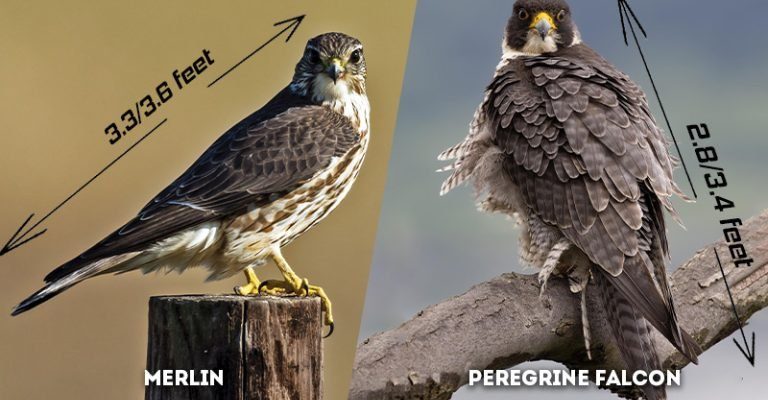![Comparing The Peregrine Falcon Vs. [Similar Species]](https://gudri.com/wp-content/uploads/2025/06/Comparing_The_Peregrine_Falcon_Vs___Similar_Species__image_0.jpg)
Imagine you’re watching a high-speed race between these two birds. The Peregrine Falcon dives like a rocket, reaching speeds over 240 miles per hour, while the Merlin zips around with agility and precision, chasing smaller birds with a determination that’s hard to miss. So, what exactly sets these two apart? Let’s break it down, so you can appreciate what makes each of these winged wonders special.
Physical Characteristics
When it comes to looks, the **Peregrine Falcon** and the **Merlin** have distinct characteristics that make them stand out. The Peregrine is larger, with a wingspan of about 3.3 to 3.6 feet and a length of 15 to 20 inches. Its striking blue-gray feathers and unmistakable black cap give it a regal appearance. You might think of it as the “king of the skies,” ready to take on the world from above.
On the flip side, the Merlin is much smaller, standing at only 9 to 13 inches long and boasting a wingspan of about 20 to 25 inches. It features a more compact build, which allows it to dart through tree branches and bushes. Its plumage is generally brown with streaks and spots, making it blend well with its surroundings. If the Peregrine is the king, then the Merlin is like a feisty knight, always on the move and ready for action.
Habitat and Range
Where do these two birds choose to call home? The **Peregrine Falcon** prefers open areas with plenty of high perches, like cliffs, skyscrapers, or towers. You can find them in various habitats around the world, from urban cities to remote wilderness areas. They often migrate seasonally, seeking warmer climates during winter.
The **Merlin**, on the other hand, enjoys a bit of a different lifestyle. These birds favor open grasslands, coastal areas, and even some forest edges. They tend to stay in the northern parts of North America and Europe, migrating short distances in the winter. You might spot a Merlin perched on a power line or darting through low shrubs, always on the lookout for its next meal.
Feeding Habits
Feeding habits are where these two birds really show their differences. The **Peregrine Falcon** is known for its incredible hunting prowess. They often hunt by diving at high speeds to catch their prey mid-air. Their diet mainly consists of birds, which they catch with sharp talons. This method not only showcases their speed but also their excellent eyesight.
The **Merlin**, while also a hunter, uses a slightly different tactic. This little bird is a bundle of energy, chasing after smaller birds like sparrows and finches. Instead of diving from great heights, Merlins rely on quick sprints through the air, surprising their prey with bursts of speed. It’s like watching a sprinter take off on the track, weaving in and out with precision to catch dinner.
Behavior and Social Structure
Both birds exhibit intriguing behaviors. The **Peregrine Falcon** is mostly solitary, except during mating season. When they’re not hunting, you might see them soaring high in the sky or resting on ledges. Their calls can be quite loud and distinctive, a strong way to communicate with each other.
In contrast, the **Merlin** tends to be more social. During breeding seasons, you can find them in pairs, and they often hunt in groups. Their lively and playful nature makes them fun to watch, as they chase each other through the skies, displaying their acrobatic skills.
Breeding and Nesting
When it comes to raising a family, both birds have unique approaches. The **Peregrine Falcon** typically nests on high cliffs or man-made structures, laying about 3 to 5 eggs. The female does most of the incubating, while the male brings food. After hatching, young falcons (or eyasses) rely heavily on their parents for food and protection until they’re ready to fledge.
The **Merlin** chooses more hidden locations for its nests, like small trees or shrubs. They usually lay around 4 to 5 eggs as well. After hatching, both parents share the responsibility of feeding their young. Their nesting behavior highlights a beautiful aspect of nature—both species are dedicated caregivers, ensuring the survival of their young.
Conservation Status
Both birds have faced challenges due to habitat loss and environmental changes. The **Peregrine Falcon** was once endangered due to pesticide use, but thanks to conservation efforts, their populations have rebounded significantly. Now, they’re listed as a species of least concern, a testament to successful protection initiatives.
The **Merlin** has not faced the same level of threat, but habitat changes still affect their populations. They are generally stable, but it’s essential to continue monitoring their habitats and feeding grounds to ensure they stay safe and protected.
Fun Facts
Let’s wrap things up with some cool tidbits about our feathered friends.
- Peregrine Falcons can dive at speeds over 240 mph, making them the fastest bird on the planet!
- The Merlin is known for its agility, being able to change direction quickly to catch its prey.
- Peregrines have a unique “tooth” on their beaks that helps them kill their prey swiftly.
- Merlins often hunt in short bursts, which can make them hard to spot because they’re always on the move!
In comparing the **Peregrine Falcon** and the **Merlin**, it’s clear that both birds bring something unique to the table. The Peregrine, with its impressive speed and fierce hunting skills, stands as a symbol of power in the avian world. Meanwhile, the Merlin charms us with its vivacious spirit and adaptability, proving that size isn’t everything.
Understanding these differences helps us appreciate the diversity of life around us. Whether you’re watching a Peregrine soar majestically overhead or catching a glimpse of a Merlin zipping through the bushes, each bird has its place in nature’s intricate tapestry. So next time you see one of these incredible raptors, take a moment to admire their uniqueness—each a marvel in its own right.

